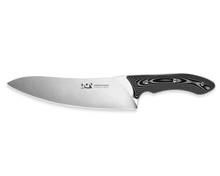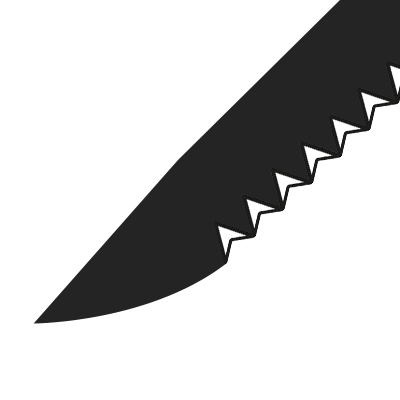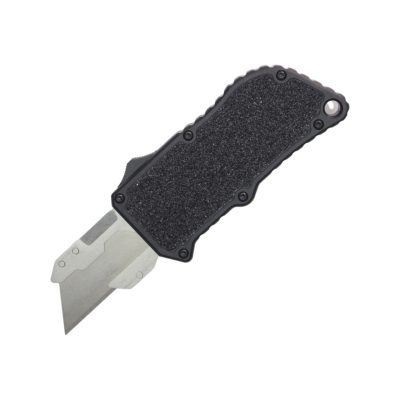For most EDC owners, serrated blades are something that you find on steak knives. However, in recent years, an increasing number of everyday carry, tactical, OTF, and folding pocket knives have begun to feature knobbly edged blades. Why do people choose a serrated folding pocketknife, and should you consider getting one?
The Three Basic Types of Knife Edges
Saying that knives have three common kinds of edges might seem a little disingenuous. Those who have studied the technicalities inherent to knifemaking understand that numerous factors influence an edge, such as varying types of grinds, bevels, blade shapes, point shapes, blade lengths, blade thicknesses, and so on. Ignoring such complexity for a moment, though, a casual examiner can easily delineate a simple trio of edges.
First comes the plain edge, which is the kind of knife that most people instantly think of. No matter a knife’s length, shape, or thickness, a plain edge features an undifferentiated cutting surface from the knife’s hilt (or at least near the hilt) to its point. Consistency is the name of the game with a plain edge.
Next you’ll find the subject of this article: the serrated edge. These sorts of edges are the opposite of plain edges, meaning that they feature a variegated pattern along the entirety of their cutting length. Serrations somewhat resemble teeth, although knifemakers choose their own patterns. Some of these patterns include symmetrical scalloped teeth, alternating wide and thin teeth, shallow teeth, deep teeth, squared-off teeth, and more. Each of these offer a slightly different cutting experience.
Finally, some knives try to incorporate the advantages of both serrated and plain edges by creating a hybrid edge. These sorts of blades typically feature a plain edge from the point to the midway point with the remainder being serrated.
Understanding How Knives Cut
Why do users prefer different kinds of knife edges? In order to understand why some might select a serrated blade, it helps to know the ways in which knives can cut.
The slice is a self-explanatory kind of cut and has the user press the edge of the knife into an object before moving it back and forth. Unless you’re watching a sword-and-board fantasy movie, slicing something — be it meat, bread, rope, hide, clothing, wood, or a roughly similar material — will require multiple slices. When you saw something, you’re simply making a specific kind of slice.
The push cut and pull cut are both subsets of the slice, except that the user only exerts pressure in a single direction, lifting the knife and reorienting it at the end of every stroke. Typically, you’ll find these sorts of cuts used in culinary tasks like preparing herbs or slicing thin-skinned fruits or vegetables. They’re intended to be used in delicate tasks where more strenuous actions might damage the cut material.
Just like slicing, the chop is a natural motion to use with almost any sort of bladed implement. Instead of employing a sliding motion, the chop involves swiftly moving the knife’s edge in a single direction (usually downward) and then withdrawing it. This movement gets employed by chefs and lumberjacks alike, but not every blade is equally suited to chopping, which we’ll discuss in greater detail below.
Finally, the stab is a less common motion, although not one to discount. Thrusting the point of a knife into an item or (God forbid) an individual has applications in hunting, fishing, bushcraft, woodworking, and some forms of cooking.
The Pros and Cons of Serrated Edges
As you have likely surmised, even though there are only a small number of standard knife cuts, few blades can excel at all of them. This is especially true when it comes to serrated edges. In this section, we’ll discuss the very real advantages of serrated knives and some use cases where they simply can’t excel.
Advantages of Serrated Edges
When considering the advantages of serrated knives, the biggest boon they offer is the ability to slice well and to slice quickly. All of those little teeth add up to extra sharpened surface area, and no matter which way you may push it, a serrated edge is guaranteed to slice something. And when time is of the essence, such as when paramedics need to swiftly remove clothing from a patient or free an injured party from an entangling seat belt, a serrated blade is ideal.
Serrated knives also allow users to slice hard or tough materials. Think of a hank of rope and how hard it would be to whittle away at it with a plain edge. Serrations can cut through them much more easily.
Sometimes, you may find yourself struggling to cut material when you can’t apply even or consistent pressure. In these contexts, serrations are ideal. You may not be able to make much of a dent at all with a plain edge, but serrations can get the job done.
Disadvantages of Serrated Edges
Unfortunately, serrated knives struggle with any kind of cut except slicing. Their lack of an even cutting surface makes chopping impractical, and while stabbing can work, much of its efficacy will be determined by the tooth type.
Why didn’t we mention push and pull cutting yet? Well, that’s because these particular techniques highlight a universal problem with serrated knives, namely that they don’t make clean cuts. Serrated knives can make short work of many cutting tasks, but all of those teeth with their varying angles of attack tend to chew through material.
One sad reality of every knife is that it will eventually become dull. Products to restore an edge have multiplied in the market, but the vast majority of them are designed for plain edges. The best way to sharpen serrations is by running an appropriately sized diamond or ceramic rod over both sides of each individual tooth. That makes serrated knives hard to sharpen.
Should You Buy a Knife with a Serrated Edge?
As with so many knife styles, the choice of a serrated, plain, or hybrid folding pocketknife will depend on your use case. Have a garden that you want to tend? Work on a ranch or farm? Do you want to cut through stubborn materials like rope or synthetic fibers? Will you need to slice something quickly and without subtlety? Then a serrated folding pocketknife may be just what you’re looking for.
We offer many kinds of plain and serrated blades here at TacKnives. See our selection here.
-
$129.95 Select options This product has multiple variants. The options may be chosen on the product page
-
Rated 4.87 out of 5$69.95 Select options This product has multiple variants. The options may be chosen on the product page











